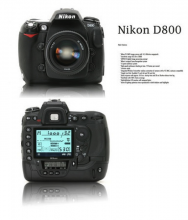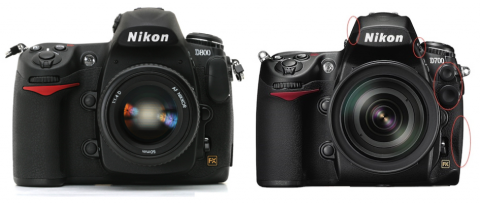The Newly Launched Nikon D800
Nikon has recently launched the Nikon D800, a marvellous hybrid camera that unites several of the powerful characteristics of the D4 and the body style of the popular D700 and features a high resolution 36.3MP sensor. The first batch arrived near the end of March and the D800E arrives during the month of May. This camera will set a new standard in digital photography.
The D800 has many new features and improvements, including a better dynamic range and an excellent ISO function. The ergonomics have been improved along with the auto-focus and the shutter durability. The viewfinder gives 100% coverage and the model is smaller than the D700.
The two models, the D800 and D800E have only one major difference: the D800E does not have an anti-aliasing filter. This filter stops colour moiré appearing in recurring patterns, caused by the RGB Bayer sensor. The new filter in the D800 model partially reduces sharpness, so the D800E would be a better choice for photographers looking for optimal detail and sharpness.
If you understand how moiré is created, you will be able to avoid taking photos of things that causes it, because not all software is able to eliminate it. The anti-aliasing filter is in the spatial domain and once moiré is captured most software is unable to tell the difference between it and other natural patterns.
Basically moiré is made by patterns that repeat themselves, i.e. grids and some textiles, which have specific patterns. However, things like landscapes fauna and flora are likely to produce less specific repetition patterns and so can occur randomly. If you are a nature photographer, the D800E should be perfect for your needs, while if you tend more towards cityscape, textile and industrial photography you would be better off with the D800.
The D800 is a serious competitor in the medium format camera market and is more affordable. Although medium format cameras have a shallower DOF because they use a bigger sensor that needs less intensification and larger pixel size, the D800 features a high resolution sensor and an exceptional dynamic range.
It looks and feels pretty much the same as the D700, but has been slightly modified to accept the new prism and its overall shape has been improved. It features a bracketing button that the D700 did not have and a new video recording button which can be customised while it is in still image mode. The shutter release button has been adjusted to 35°.
The back of the D800 is pretty much the same as the D700 and the D4 models, but with an added movie selector and a still image mode and without an auto-focus area mode which is now to be found on the front of the camera.
Both the D800 and the D800E have a 36.3MP, full frame FX CMOS sensor which measures 35.9mm x 24.0mm, newly designed by SONY. It produces images at higher resolutions (7360 x 4912). In DX crop mode, it will turn out 15MP images making for better pixel integrity that will rival the results produced by the D7000. The sensor has the added advantage of being exceptionally versatile. The camera has a dust reduction auto-cleaning system.
The results of testing carried out on the D800 and D800E by DxOMark, give the camera the highest score of all other cameras on the current market. One of the DxOMark’s tests is “Signal to Noise Ratio” or SNR using a 100% screen-view which represents noise on a pixel level. The D800 registered noise at roughly 1 – 1.5 stops less than the D4; using the latest sensor enhancements, Nikon are now better able to handle dark noise.
Other sensor scores given by DxOMark to the D800 include Portrait (colour depth) at 25.3 bits, Landscapes (dynamic range) at 14.4 EVs and Sports (low-light ISO) at 2853 ISO. While medium format cameras can produce better colour and tonal range and SNR at a lower ISO range in studio work, they are much less sensitive to light. The D800 performs exceptionally well at medium to high ISO levels.
The D800 has a new Auto ISO function incorporating the lens’ focal length when in A or P modes. This gives you control over the shutter threshold by using the inverse of the lens’ focal length, by setting Auto ISO to “On” and setting maximum sensitivity and minimum shutter speed. Then you just have to adjust the focal length interpretation speed. You can control Auto ISO by simply selecting the ISO icon and turning the sub-command dial.
The D800 has and advanced metering and scene-recognition system, which detects variations between natural and artificial light and which compensates automatically when lighting conditions are difficult. Using i-TTL-BL and i-TTL flash metering, it greatly improves flash exposure. It also lets the D800 use face detection with “phase-detect” and with “contrast auto-focus” and can be used using the viewfinder.
The auto-focus system is the sophisticated multi-cam 3500FX and allows an open aperture of f/8 in the centre focal point. The system’s characteristics include three AF areas: 9, 21 and 51 point and a 3D tracking mode. The auto-focus mode is now on the front of the camera and is a button to be found on the auto-focus drive control. Select this button and modify the command dial to go through the auto-focus modes.
Other new functions include improved viewfinder coverage, a virtual horizon with pitch and roll indication and added precision for manual focus modifications. It also has a 5:4 crop option and a 1.2X crop element for telephoto edge, full frame FX and DX. This saves time as you can crop before post-production and also saves on your image-file size, data transferring and processing.
The D800 also offers 2-frame HDR within a single shutter release, processing 16-bit, with exposure differences of up to 3EV. The rear display is 3.2 inch LCD with auto-brightness and 921K dot TFT and sRGB colour range and a broad viewing angle. It works exceptionally well in live view for your macros or landscapes, ensuring precise focussing at 23X zoom.
The D800 has various connection points: USB 3.0, HDMI type C, 10-Pin accessory terminal, Audio-In 3.5mm pin-jack and Headphone-Out 3.5mm pin jack. It has dual memory-card slots for SD/SDHC and CF cards for high resolution images at 4 fps.
The overall dimensions of the D800 are 5.7ʺ x 4.8ʺ x 3.2ʺ. It weighs 900g without its battery. The D800 package includes:
- EN-EL5 Battery and charger
- USB Cable and clip attachment
- Body Cap
- Shoe Mount Cover
- LCD Cover
- Eyepiece
- Camera strap




